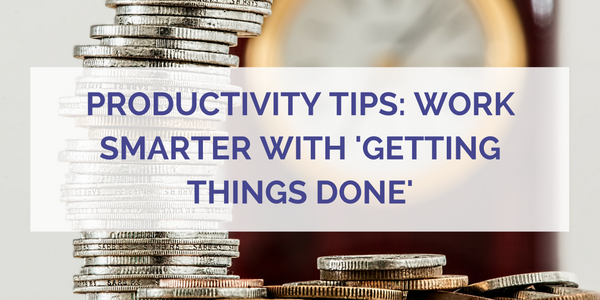
Getting Things Done, or GTD for short is an excellent method of organising your to-do list, to make it more manageable and increase the likelihood of you actually completing each task. The concept was devised by productivity consultant, David Allen, and became a bestselling book. GTD helps you get all of your to-dos out of your head and down on paper (or into any productivity software you use) and helps you decide in which order you should complete each task.
This article, one of many in our productivity series , will explain how GTD works and how you can use it to work smarter, not harder, in your day to day life.
What is Getting Things Done?
GTD uses five core principles as it’s foundations; capture, clarify, organise, reflect and engage. By understanding each principle, and putting them into practice in your daily workload, you will be on the way to a much more productive work day.
Capture
To ‘capture’ means to record every task you have in your head on a to-do list, notebook, or any organisational software you regularly use. You can use whatever method suits you best but it must be quick and easy and provide no obstacles to you completing your tasks. Capture absolutely everything, from tasks to meetings, emails to household chores. The idea is that you get everything down so you don’t have to add anything to your list later as this will ruin the process.
Clarify
The clarification principle requires you to go into detail on every task. Break down each task into subtasks so you know exactly where to start for each. This will help you avoid getting sidetracked by thinking about how you will complete mammoth, complicated tasks. Do small tasks immediately and delegate anything you don’t have to do yourself? This will leave you with a well-organised list of things you absolutely need to do and an idea about how you will complete each task.
Organise
Next, prioritise your to-do list and set due dates and reminders for each task. This will help you ensure you have time allocated to complete each one and ensure you don’t forget about any of them if you get side-tracked by meetings or work that you hadn’t originally planned for. The organisational stage is vital to the success of GTD so don’t rush it, take the time to thoroughly consider each task and understand when each must be completed and what you will need to do along the way.
Reflect
Before getting down to work, take some time to reflect on your to-do list. Look at the tasks with the highest priority and consider which you will tackle first. This is the beauty of the clarification stage as it helps break down tasks into chunks. You can pick and choose the chunks you are most comfortable with to get started.
Engage
Now is the time to get working. By now, you should have a thoroughly organised system that outlines what you should be doing now and what should be next on the list to complete. Tick off each task as you go and if you find a task that is still too vague and requires thought, break it down into further manageable chunks.
GTD should help you organise and rationalise your day to day to do list so you can spend more time working and less time thinking or procrastinating. For more tips on how you can be productive, read our recent blog post on the Pomodoro Technique.
Written by Mike Pye